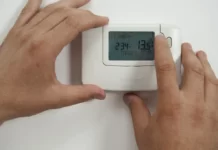Most people are familiar with vinegar as a cooking ingredient. Yet, very few people know that it is a more than perfect cleaning agent. The reason that vinegar is ideal for cleaning or disinfecting purposes is that it contains acetic acid. You might recall from your chemistry classes that acid is a potent chemical.
So, if you ever need to clean or disinfect something, opt for vinegar. If you do not have vinegar or prefer not to use it to clean your Keurig coffee maker, keep reading. Today’s article is all about how to clean a Keurig coffee maker without vinegar. Let us start.
5 Ways to Clean a Keurig without Vinegar
There are various methods to clean a Keurig coffee maker without vinegar, including:
1. Citric Acid
If you are not using vinegar, then we recommend lemons. Yes, we are not joking, and you read that right. Lemons are a great alternative. Many of us may even use it to clean spots on our clothes. Why? Lemons and limes contain citric acid. Citric acid kills bacteria and is effective at removing mineral buildup in your coffee maker.
Hold on! We are not saying that you should start rubbing lemons or limes in the coffee maker. You can easily find citric acid in powder form at your local grocery shop. So, instead of rubbing lemons, go and buy citric acid. If you are not using citric acid, you may use lemon juice. But you will need a lot of it.
Suppose you are using citric acid. Mix half an ounce of citric acid with 1.25 cups of water. In the case of lemon, you will need equal amounts of water and lemon juice. Pour the mixture into the Keurig water reservoir. Once done, place a large cup or container underneath the brewer. Press the start button.
Some Keurig machines come with a large reservoir. In that case, you might need to repeat the above process multiple times. Rinse the holder with water to ensure that the solution is completely removed. Ensure that the reservoir is clean before using the machine to brew your next coffee.
2. Keurig Descaling Solution
Another way how to descale Keurig without vinegar solution is by using Keurig descaling solution, which you can easily find at any grocery shop. It is the only recommended solution to clean your Keurig coffee machines. How do I use it? Pour the solution into the water reservoir. Once done, fill the empty solution bottle with water and then pour it into the reservoir. Then, proceed to perform a cleansing brew.
You will need to repeat the cleansing brew process until you see the ‘Add Water’ light come on. When it does, leave your coffee maker for at least 40 minutes. The idea is to let it rest. Otherwise, it might overheat. After that, you need to rinse the reservoir. Refill it with water and perform 12 rinsing brews. We recommend that you use the descaling solution every 3 months.
3. Baking Soda
It is another natural cleaning agent. All you need to do is mix 1-4 cups of baking soda and water into the reservoir. Run the machine 3 times and then rinse the reservoir with clean water. It will ensure that there are no leftovers in the reservoir. If you are comfortable with this choice, then perform it once every 3 months. It will prolong your coffee maker’s life and retain its taste.
4. Using Lemon Juice
Lemon juice is a natural descaling solution that can effectively remove mineral deposits from your Keurig. It is also a good choice if you are sensitive to the smell of vinegar.

Here are the steps on how to use lemon juice to clean your Keurig:
- Rinse the water reservoir with hot water. This will help remove any loose dirt or debris.
- Fill the reservoir with hot water and add 1/2 cup of lemon juice. Make sure to use fresh lemons, as bottled lemon juice may not be as effective.
- Let the solution sit for 30 minutes. This will give the lemon juice time to work its magic and dissolve the mineral deposits.
- Rinse the reservoir with hot water. This will remove any remaining lemon juice and mineral deposits.
- Descale the needle by running white vinegar or a descaling solution through it. This will help to remove any mineral deposits that have built up on the needle.
- Run a few cycles of fresh water through Keurig to remove any traces of lemon juice or descaling solution. This is important to ensure that your coffee doesn’t taste like lemon or vinegar.
4. Bleach
You may use bleach to clean the Keurig coffee maker. However, we recommend against it if you are not familiar with using it. The reason is that it is an extremely powerful cleaning agent. If not handled properly, it can damage the coffee maker. Nevertheless, it remains one of the best ways to descale a Keurig without vinegar.
FAQs
Q. How Often Should I Clean My Keurig?
The answer depends on your use. If you use it frequently, we recommend cleaning it at least once every two months. If you use it seasonally, you can clean it before putting it away. Regular cleaning will prolong its life and ensure that you get the best possible taste. Otherwise, you might feel a difference in the taste and not in a good way either. Depending on the model, your Keurig coffee maker might come with a descale button. It certainly makes things a whole lot easier. When it comes to the water reservoir, you should give it a thorough clean once every week.
Q. What are the signs that my Keurig needs to be cleaned?
There are a few signs that your Keurig needs to be cleaned. These include:
- Slow water flow
- Water that is not as hot as it used to be
- Mineral deposits on the needle or in the water reservoir
- Coffee that tastes off
Q: What can I do to prevent my Keurig from needing to be cleaned as often?
There are a few things you can do to prevent your Keurig from needing to be cleaned as often. These include:
- Using filtered water
- Rinsing the water reservoir regularly
- Descaling the needle every few months
Q. Can I Use Tap Water In My Keurig?
While the scale and mineral build-up are normal after frequent use, tap water can accelerate it. The reason is that tap water itself contains scales, calcium, and other minerals. So, we recommend that you use filtered water. If you do not have filtered water, you can boil it and then use it. When using filtered or boiled water as compared to tap water, you will feel a difference in the taste.
Wrap Up
In conclusion, maintaining a Keurig without vinegar is not only possible but also straightforward. By utilizing alternative cleaning solutions, such as a combination of water and citric acid or specialized Keurig cleaning products, you can effectively remove mineral deposits and keep your Keurig operating at its best. These methods not only eliminate the need for vinegar but also ensure a pristine machine and a consistently delightful coffee experience.












